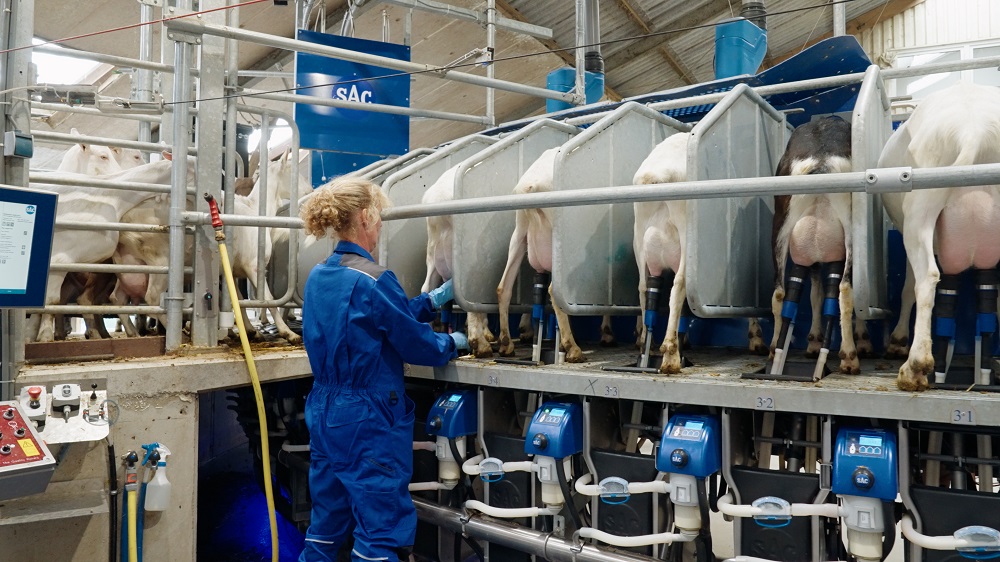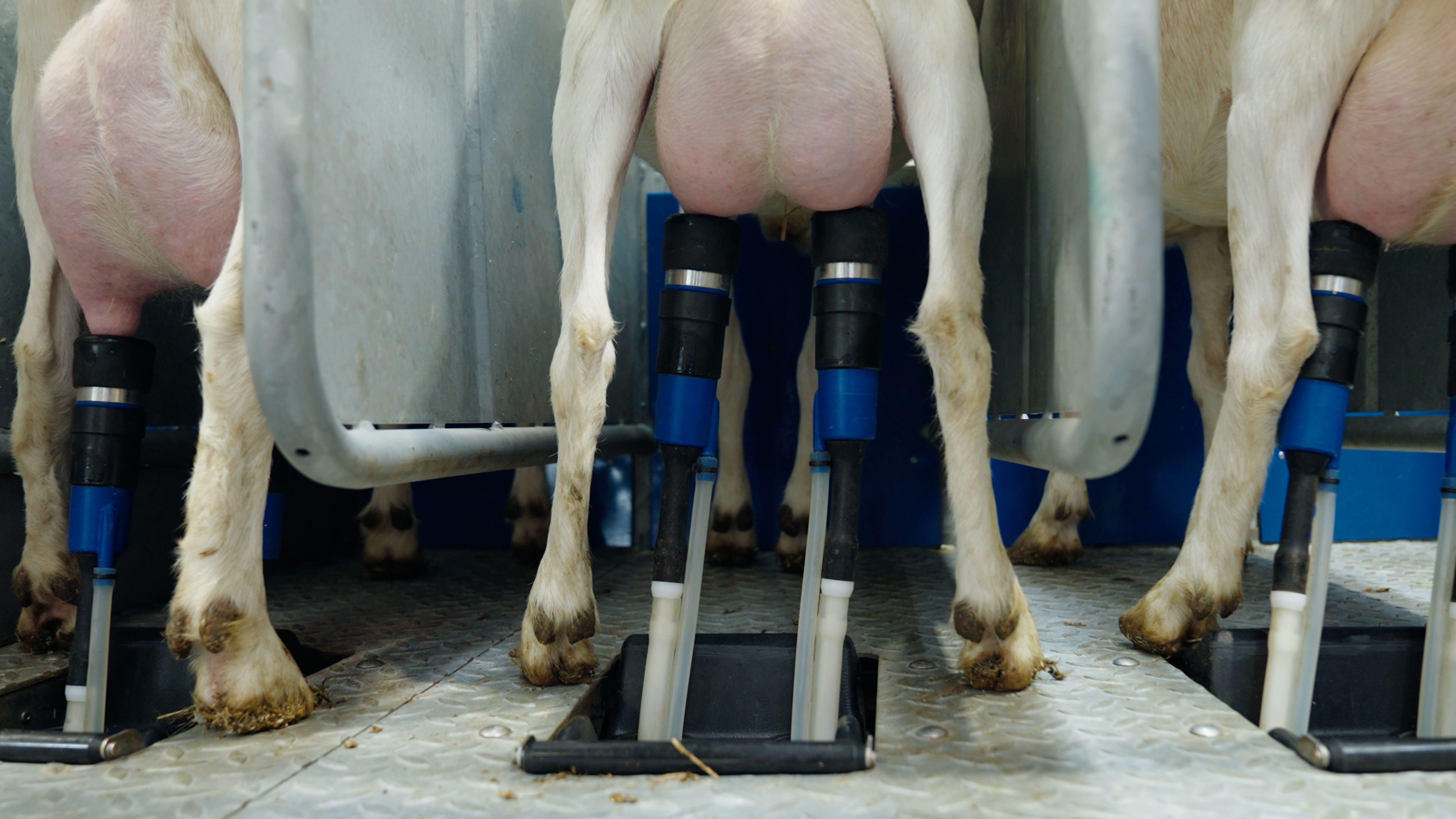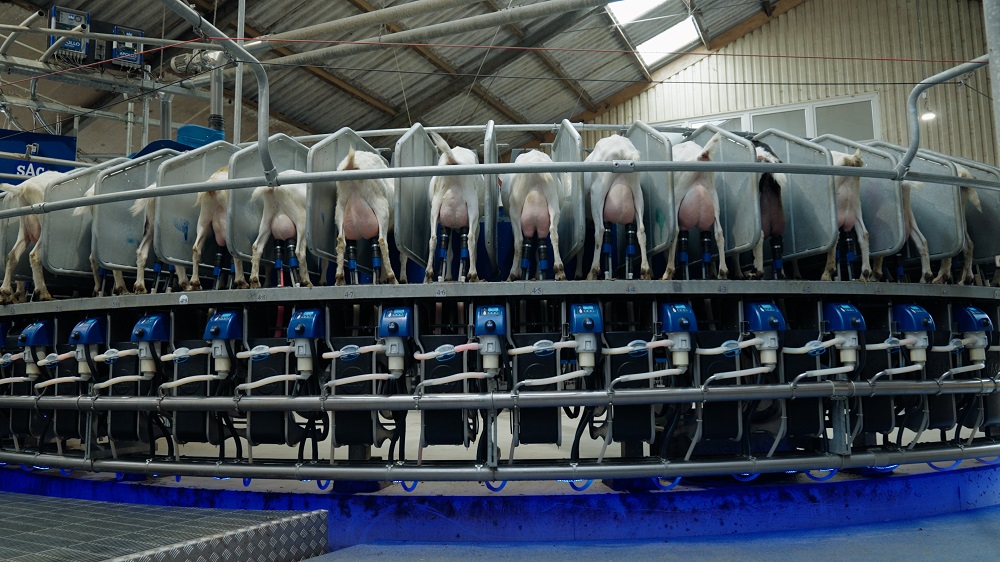On the job
“Our milk is produced in a top-end milking parlour"
Back in early 2022, business owners Atte and Hanny Wiarda-Galama switched from cows to goats. A massive change which the couple have simply taken in their stride. Their 900 goats are milked using the very first SAC 2RO on the market. The 2RO is an outdoor rotary milking parlour. “Milk quality is excellent, and the goats are comfortable during milking. We really enjoy the milking process."
Although Atte and Hanny had never milked a goat before, they knew exactly what to expect from their new parlour, which is integral to the success of the farm. They had seen the first demonstrations of the 2RO outdoor milking parlour, which SAC engineers were constructing at the time. “They made an exception and allowed us to watch,” explains Atte, sat at their kitchen table in Raerd, Friesland. “We were convinced this was the perfect system for our farm before even leaving the demo."
The final 2RO design was yet to be fully realised. This was in the summer of 2021, still a few months before the couple switched to goats. In early 2022, Atte and Hanny started milking their goats using the new 2RO system. “In reality, we received the trial version,” says Atte, laughing. “It worked brilliantly from the start. A few adjustments were needed, but nothing major. From day one, the goats were milked correctly. Our partnership with SAC, and the support we’ve received, has been excellent.” When the parlour requires an update, a mechanic is always on site. “They stay until cleaning processes have finished, to assist with any potential faults."
Fast and efficient milking
After a year of use, Atte and Hanny describe the rotary parlour as robust and fitted with proven technology. “Milk quality is excellent, and the goats are comfortable during milking. We really enjoy the milking process." Their enjoyment is enhanced by the QuickUp; the teat cups that are easily applied to the goats from the platform. Ergonomically speaking, the patented QuickUp system has many advantages, as it only requires a vertical movement to attach the lightweight cups It also offers many advantages for the goats. “Every type of goat can be milked; small, large, tall, short and different types of teats."
The rotary milking parlour allows the farmers to stay in the same place for the entire milking process, while the goats are rotated at a constant speed. “It’s similar to the rotary parlour we used to milk our cows for twenty years,” says Atte, adding that they always work together when milking the goats. “One of us works in the parlour, while the other manages feed and other tasks." The goats are quick to arrive, as they can’t resist the treats we use to entice them into the rotary parlour.”
The new system was built in the existing barn, and includes a waiting pen where approximately 600 goats can be grouped. “The maximum waiting time for the goats is 45 minutes, any longer is simply too long,” explain the goat farmers. “Ideally, the goats should be back in their own barn as quickly as possible, where they can eat, lie down, relax, and produce more milk." It takes little more than 90 minutes to milk the entire herd, clean the milking parlour and feed and care for the goats. “The milking process has to be fast and efficient, which is something we’d already learned with our cows."
Applying technology increases efficiency
Technology is indispensable to the 2RO. Goats that disappear from sight during milking are monitored by the computer. “If a goat only achieves 75% of their milk production, they stay in the parlour,” mentions Atte as one the major advantages of the system. “The goats are monitored continuously, without us having to walk back and forth to check." The goat farmers are also full of praise for the advanced technology their milking system offers, one example being its separation capabilities. “We use this a lot." It enables goats to be separated from the larger group, for example for the smaller breeding group. “This eliminates the really time consuming job of searching through the flock to find a specific goat. We simply enter information on the goats we need to remove from the group. They are then sent to a separate pen, ready for inspection. This saves a lot of time.” Atte has done the calculations. “If you save ten minutes a day on recurring jobs, it adds up to an hour saved every week and a week saved every year."
Computerised work
It’s mainly Hanny who works with the computerised system. “First thing in the morning, I can see straightaway which goats haven’t produced enough milk." She selects these particular goats by entering their information on the user friendly touchscreen. “This saves so much time, as we no longer have to look for specific goats. By selecting them, I know exactly which goats I need to observe.” She says that technology can be used to further increase labour efficiency. “The computer knows everything, so this really is a parlour that works with the farmer. Milking remains human work, but now we can learn to follow the signals provided by the computer.” She mentions, for example, the different colours the computer shows for different issues relating to the goats. “This applies a specific observational colour code to a goat. Orange signals an insufficient amount of milk, purple means we’ve selected the goat ourselves, and green signals that everything is fine."
The capabilities of the milking parlour are enormous. “By leaving the neck lock closed, the goat stays in the parlour for another rotation and I can observe the goat again as she passes. This can be useful for a goat that’s harder to handle, for example, or when I need to check the temperature of a specific animal. It’s all done at the push of a button,” says Hanny. “If a goat is sick, there’s no time to lose, as they are a lot more vulnerable than cows.” SAC really excels in technology,” Atte reiterates. “We rely heavily on it, and this really is a top-end milking parlour.”
Less capital, improved revenue model
Switching from 120 cows to 900 goats was a considerable step. The cows left the farm on 13 October 2021. The following three months were spent preparing the farm. “There were no longer any animals to care for and milk, and no calving of course. We could focus solely on rebuilding the barn in preparation for the arrival of the goats. They currently milk 900 goats, with the aim of expanding their herd to 1,100. Their current licence permits this increase. “Adding 200 extra goats increases our milking time by just fifteen minutes, so expansion will be easy.”
Busier than ever but no regrets
The goats arrived from two different farms on 18 January 2022. “Since making the switch, I’ve had no regrets at all,” says Atte, while looking at Hanny. “Me neither,” says Hanny. “Despite our lives being busier than ever; I’m currently working two jobs."
The kidding period from mid-March to the end of May is the busiest time for the couple. This period also involves getting the goats ready for the new season. To accommodate the kids and give them the best possible start, they invested in a modern ‘maternity room', where several 'maternity carers' (temporary workers) help during the lambing period. “It’s wonderful work,” says Hanny. “Kids are more vulnerable than calves, you really need to take good care of them. We invest a lot of time in giving them a bottle and doing our work as hygienically as possible. Hundreds of kids are born within a short period, which increases the risk of infection tenfold. Working with goats is more suited to women,” laughs Atte.
Opening the farm to the public
Eight months after their new start, Atte and Hanny organised an open day. “This was also for neighbours and those living in the village. No one has ever had a bad word to say about us, which is all the more reason to give something back and open up the farm.” For fellow goat farmers, it was a great opportunity to get a glimpse of the 2RO rotary milking parlour, and admire the very first version on the global market. This also attracted many international visitors to the farm in Raerd. “We’re delighted with what we’ve been able to achieve during our first year. The goats give an average of 1,100 litres of milk per year, which is fantastic. The most important thing for us though, is the convenience and financial security it provides. Our experience has been entirely positive.”




